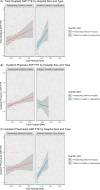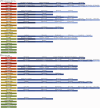Strategies, personnel, and diversity of pediatric antimicrobial stewardship programs in the United States: Strategies and composition of US pediatric ASPs
- PMID: 40026771
- PMCID: PMC11869051
- DOI: 10.1017/ash.2025.18
Strategies, personnel, and diversity of pediatric antimicrobial stewardship programs in the United States: Strategies and composition of US pediatric ASPs
Abstract
Objective: We sought to characterize US pediatric antimicrobial stewardship programs (ASPs), including their hospital demographics, staffing, funded full-time equivalents (FTEs) by hospital size, and relative emphasis on recommended stewardship strategies. We examined the self-reported characteristics of ASP personnel with regard to discipline, race, ethnicity, gender identity, and years of experience in antimicrobial stewardship.
Design: Descriptive two-part survey.
Setting: Pediatric ASPs at hospitals participating in Sharing Antimicrobial Reports for Pediatric Stewardship (SHARPS), a pediatric quality improvement collaborative of >70 children's hospitals.
Participants: Survey distributed to 82 US pediatric ASPs, excluding hospitals without pediatric ASPs. Part I completed by ASP leader (physician or pharmacist). Part II distributed to ASP team members.
Methods: Part I addressed hospital demographics, ASP funding, and program choices related to the CDC's 2019 Core Elements of Hospital Antibiotic Stewardship Programs. Part II requested that participants anonymously self-identify race, ethnicity, gender identity, training, and duration of ASP experience. Descriptive statistics performed.
Results: Sixty-two ASPs responded: 61 (98%) with formal ASP, 40 (65%) from freestanding children's hospitals. 40 (65%) co-led by an ASP physician and pharmacist. 60 (97%) reported dedicated inpatient physician FTE, 57 (92%) dedicated inpatient pharmacist FTE. Most programs (35 [58%]) reported inadequate staffing support. The 125 ASP professionals who completed Part II predominantly self-reported as White (89 [71%]), with fewer self-reporting as Asian (9 [15%]) or Black (4 [3%]).
Conclusion: US pediatric ASPs have achieved substantial progress in meeting the CDC Core Elements, but many report insufficient resources. We identified underrepresentation in the ASP workforce.
© The Author(s) 2025.
Conflict of interest statement
All authors report no conflicts of interest relevant to this article.
Figures



References
-
- Dellit TH, Owens RC, McGowan JE, et al. Infectious diseases society of America and the society for healthcare epidemiology of America guidelines for developing an institutional program to enhance antimicrobial stewardship. Clin Infect Dis Off Publ Infect Dis Soc Am 2007;44:159–177. 10.1086/510393 - DOI - PubMed
Grants and funding
LinkOut - more resources
Full Text Sources
